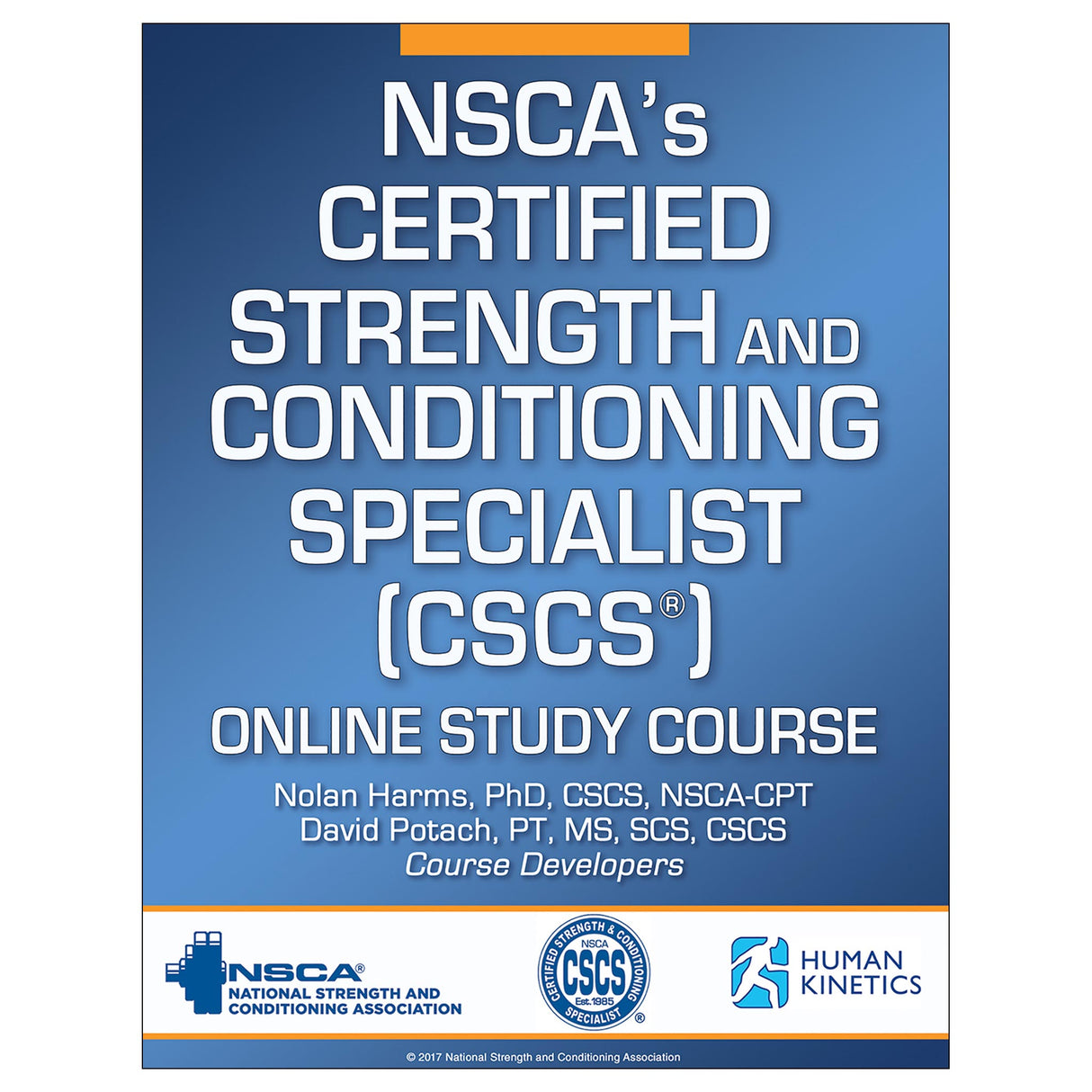NSCA’s Certified Strength and Conditioning Specialist (CSCS) 4th Edition Online Study/CE Course With Ebook
$249.00 USD
Human Kinetics strongly recommends that you complete your exam within the calendar year of your date of purchase to ensure approved credits do not expire for your organization.
- Essentials of Strength Training and Conditioning, Fourth Edition, ebook
- Online access to HKPropel including video clips and lab activities
- Online course activities
- Online continuing education exam
The course content reflects the weighting and scope of the CSCS exam and has varying levels of recall, application, and analysis activities for each primary objective. Featuring over 160 interactive learning activities, this online course offers scientific knowledge and practical application and pinpoints the information required for preparing for the exam. The content covered relates directly to the on-the-job duties and responsibilities of a certified strength and conditioning specialist, and an end-of-course test evaluates the learner’s content knowledge, mimicking the scope and difficulty of the actual certification exam. Current certified professionals who complete the course and pass the test can earn continuing education units.
The course is supplemented by content from Essentials of Strength Training and Conditioning, Fourth Edition, the primary text by the National Strength and Conditioning Association. Created by 30 expert contributors in the field, it explains the key theories, concepts, and scientific principles of strength training and conditioning as well as their direct application to athletic competition and performance. Supplementing the text are online video clips demonstrating proper exercise technique for 21 resistance training exercises. This ebook will serve as a valuable professional reference long after the course is completed.
The information presented in the course assists exam candidates in the studying process. It should not be considered the only method of preparing for the CSCS exam. Ultimately, it will be each candidate’s academic, practical, and test-taking abilities that dictate the effectiveness of the preparation materials. The information should increase the likelihood of passing the CSCS exam, but it does not guarantee a successful performance.
Course Objectives
See Table of Contents tab.
Audience
Course for those studying for the NSCA Certified Strength and Conditioning Specialist (CSCS) exam; continuing education resource for those working with clients and athletes, including fitness professionals and athletic trainers.Unit 1: Muscle and Neuromuscular Anatomy and Physiology
- Understand muscle anatomy and physiology.
- Understand neuromuscular anatomy and physiology.
Unit 2: Principles of Biomechanics
- Understand the principles of biomechanics regarding exercise selection, execution, and sport performance.
Unit 3: Bioenergetics, Metabolism, and Cardiopulmonary Considerations
- Understand bioenergetics and metabolism.
- Understand cardiopulmonary anatomy and physiology.
Unit 4: Physiological Adaptations to Exercise
- Understand physiological adaptations to exercise.
Unit 5: Athlete Differences: Anatomy, Physiology, Biomechanics, and Psychology
- Understand the anatomical, physiological, and biomechanical differences of athletes.
- Understand the psychological techniques used to enhance training and performance.
Part 2: Nutrition
Unit 6: Nutrition Factors
- Explain nutritional factors affecting health and performance.
Unit 7: Nutrition and Performance
- Explain the strategies and results of manipulating food choices and training methods to maximize performance.
Unit 8: Performance-Enhancing Substances and Methods
- Explain the effects, risks, and alternatives of common performance-enhancing substances and methods.
Part 3: Exercise Technique
Unit 9: Resistance Training Exercise Technique
- Describe, teach, and evaluate proper resistance training exercise technique.
Unit 10: Plyometric Exercise Technique
- Describe, teach, and evaluate proper plyometric exercise technique.
Unit 11: Speed/Sprint Technique
- Describe, teach, and evaluate proper speed/sprint technique (resisted and assisted sprinting, speed-strength).
Unit 12: Agility Technique
- Describe, teach, and evaluate proper agility technique (forward, backward, and lateral movements; turn, transition and stop-and-go maneuvers).
Unit 13: Aerobic Endurance Exercise Technique
- Describe, teach, and evaluate proper aerobic endurance exercise technique.
Unit 14: Spotting Procedures and Techniques
- Describe and teach effective spotting procedures and techniques.
Part 4: Testing and Evaluation
Unit 15: Test Selection and Administration
- Evaluate the sport.
Unit 16: Testing and Evaluation
- Assess the athlete, including training status, physical testing and evaluation, and primary training goal.
Part 5: Program Design
Unit 17: Program Selection
- Determine type of exercise.
- Complete a movement analysis of the sport, including sport-specific exercises and muscle balance.
- Evaluate exercise technique experience.
- Consider equipment and time availability.
Unit 18: Program Design
- Consider training status to determine training frequency.
- Consider the sport season to determine training frequency.
- Consider training load and exercise type to determine training frequency.
- Consider other training to determine training frequency.
- Use appropriate terminology to quantify and qualify mechanical work.
- Consider the relationship between load and repetitions.
- Consider 1RM and multiple-RM testing options.
- Assign load and repetitions based on the training goal.
- Determine the variation of the training load.
- Determine the progression of the training load.
- Consider multiple versus single sets.
- Consider training status.
- Consider primary training goal.
- Consider strength and power variables.
- Consider the effects of hypertrophy.
- Consider muscular endurance variables.
Part 6: Organization and Administration
Unit 19: Facility Design and Safety
- Determine how to design, layout, and organize the strength and conditioning facility.
- Create a safe training environment within the strength and conditioning facility.





